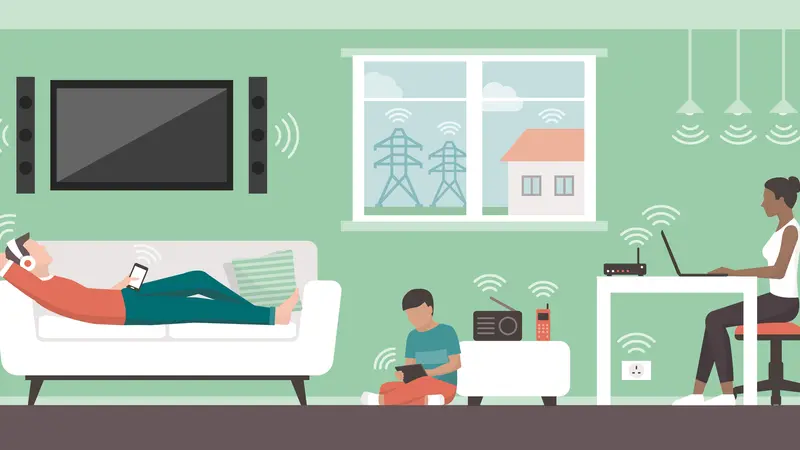

Emerging

Emerging
Children and EMFs
Children today are surrounded by devices that produce electromagnetic field (EMF) radiation, often beginning at birth. Many studies have shown that children are more sensitive to EMF exposure due to their smaller brains and thinner bones and tissues, but few studies have looked at the cumulative effect of radiation over a lifetime.
How safe is EMF exposure for kids? And are there measures you can take to protect against them?
What Is EMF Radiation?
EMFs are electromagnetic waves less than 300 GHz that are created from electric and magnetic fields. This can be in the form of radio waves, microwaves, infrared, visible light, ultraviolet light (sunlight), x-rays, and gamma rays.
Where Do EMF Waves Come From?
Anything that is powered by electricity will give off EMF radiation, but those that communicate wirelessly will be stronger, and those that broadcast wireless signals (WiFi routers and cell phones) will be the strongest of all.
Some of the household items that emit EMF radiation include:
- wireless baby monitors
- cell phones
- cordless phones
- laptop computers
- tablets
- wireless Wi-Fi routers and boosters
- hairdryers
- microwave ovens
- TVs.
Additionally, other “smart devices” that can be found in the home (e.g., electronic appliances, wireless sound systems, thermostats, doorbells, light switches, smartwatches, and personal assistants) produce additional EMFs and accompanying radiation.
Because little is known about the exact amount of EMF exposure that can affect a child’s health, precautions should be taken, especially in homes, schools, and preschools.
Is EMF Radiation Harmful?
Ionizing radiation (e.g., x-rays and ultraviolet light) has been shown to have negative effects on human health, including an increased risk of cancer, and this risk is higher for children and adolescents, as they are significantly more sensitive to radiation exposure than adults.
Many studies have also shown that non-ionizing radiation (e.g., that emitted from common wireless devices) can lead to negative health effects, including increased brain cancer among heavy cell phone users. One study that looked at EMF hypersensitivity (EHS), which used to be known as “microwave syndrome,” found that many physiologic responses occur following EMF exposure, and patients can have neurologic, neuro-hormonal, and neuro-psychiatric symptoms following exposure to EMF as a consequence of neural damage and over-sensitized neural responses.
These physiological responses include:
- significant activation of free radical processes
- altered neurological and cognitive functions
- disruption of the blood-brain barrier
- cardiovascular symptoms
- effects on skin, microvasculature, and immune and hematologic systems.
Research has shown that children may be more vulnerable to EMF than any other age group, as children are exposed to EMFs over a longer period than adults, their nervous systems are in the process of development, and the conductivity of children is higher due to higher moisture and ionic content than adults. Research has also shown that children can absorb up to ten times the radiation in the bone marrow of their skulls than adults.
How Can We Protect Against EMFs?
Because little is known about the exact amount of daily EMF exposure that can affect a child’s health, precautions should be taken, especially in homes, schools, and preschools.
Suggested precautions for parents include:
- Avoid long-term exposure to strong EMFs in home, school, or other places children spend much of their time.
- Avoid using smartphones directly against your child’s head.
- Keep your child’s body from getting hot while using mobile phones.
- Do not allow your child to use smart devices during meals or for the last hour before bed.
- Ask your child’s pediatrician for information to guide your child's use of smart devices.
Parents should also note that the effects of various devices using virtual reality and WiFi have on the neural development of children remain unknown, and that most products that claim to reduce EMFs are ineffective or unproven.
The American Academy of Pediatrics (AAP) also offers recommendations to families on how to minimize EMF exposure, including:
- Use text messaging when possible, and use cell phones in speaker mode or with the use of hands-free kits.
- When talking on the cell phone, try holding it an inch or more away from your head.
- Make only short or essential calls on cell phones.
- Avoid carrying your phone against the body like in a pocket, sock, or bra.
- If you plan to watch a movie on your device, download it first, then switch to airplane mode while you watch in order to avoid unnecessary radiation exposure.
- Keep an eye on your signal strength (i.e., how many bars you have). The weaker your cell signal, the harder your phone has to work and the more radiation it gives off.
- Avoid making calls in cars, elevators, trains, and buses. The cell phone works harder to get a signal through metal, so the power level increases.
Other strategies to reduce EMFs in the home include:
- Turn off your WiFi router at night.
- Do not have cell phones near the bed at night, or put it on airplane mode, which will prevent it from emitting EMF radiation.
- Use wired connections whenever possible, including speakers, land line phones, baby monitors, keyboards, mice, and even your Internet connection.
- Avoid “smart appliances” that communicate via WiFi, such as refrigerators, ovens, washing machines, etc.
- Do not use a cellular reception booster.
- Do not use “smart home” devices, wireless lighting, wireless thermostats, wireless cameras, etc.
- Try to opt out of a smart meter from your utility company. Smart meters emit short, frequent, powerful bursts of EMFs.
- Do not place headboards against an electrical outlet. Some outlets emit relatively high levels of EMFs, especially if the wiring is old or done incorrectly.
- Check your home for “dirty electricity,” and if needed install filters.
- Purchase an EMF measuring meter to look for problem areas in your home.
REFERENCES
HealthyChildren.org. (2016, June 13). Cell phone radiation & children’s health: what parents need to know. American Academy of Pediatrics. https://www.healthychildren.org/English/safety-prevention/all-around/Pages/Cell-Phone-Radiation-Childrens-Health.aspx
EMF Harmony. (n.d.). How to protect yourself from EMF in your home? https://emf-harmony.com/pages/how-to-protect-yourself-from-emf-in-your-home
EMF Harmony. (2022, January 22). Protecting your child from EMF radiation. https://emf-harmony.com/blogs/news/protect-your-child-emf-radiation
Environmental Health Trust. (n.d.). Research on children’s vulnerability to cell phone radio-frequency radiation. https://ehtrust.org/research-on-childrens-vulnerability-to-cell-phone-radio-frequency-radiation/
Moon, J.H. (2020). Health effects of electromagnetic fields on children. National Institutes of Health. National Library of Medicine. National Center for Biotechnology Information. https://www.ncbi.nlm.nih.gov/pmc/articles/PMC7642138/
World Health Organization. (2016, April 29). Ionizing radiation, health effects and protective measures. https://www.who.int/news-room/fact-sheets/detail/ionizing-radiation-health-effects-and-protective-measures
Stein, Y., Udasin, I. Electromagnetic hypersensitivity (EHS, microwave syndrome) — review of mechanisms. National Institutes of Health. National Library of Medicine. National Center for Biotechnology Information. https://pubmed.ncbi.nlm.nih.gov/32289567/


 By
By







